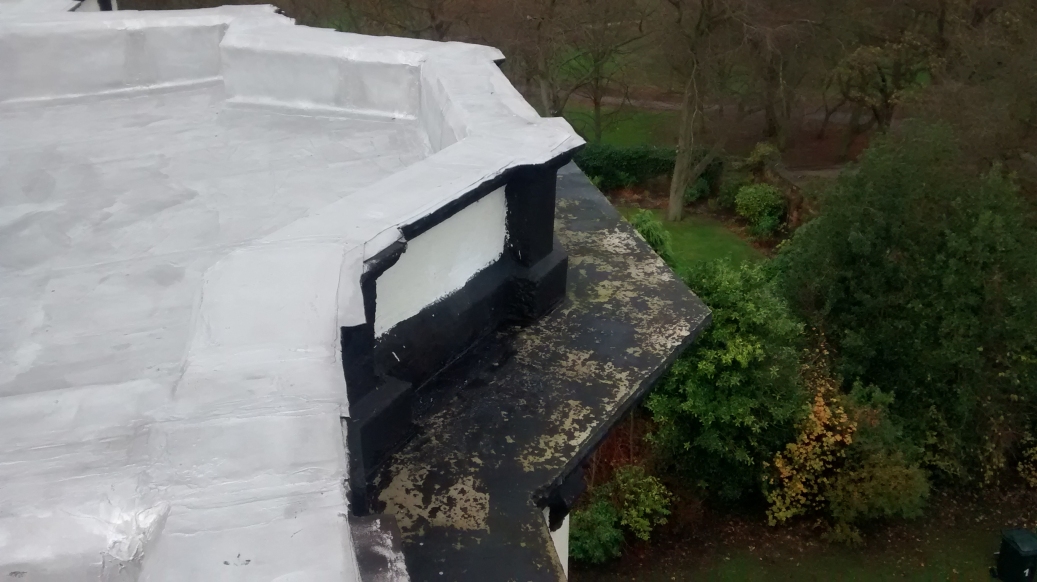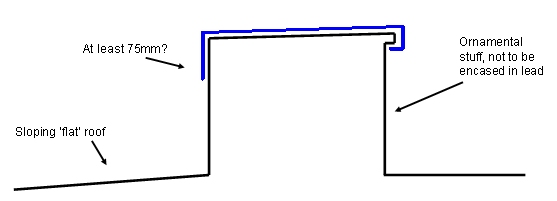Good morning,
I'm preparing to spend some money on my roof. I've had 3 companies around and all 3 have said that my roof, when done back in 2014, should really have had lead put around the top of the parapet (if I'm using the wrong word there, forgive me, I mean the big chunky bit that is sticking upwards).
I've asked about this roof before on the forum (but, back then, I was focused on the horizontally projecting parts - the "projecting eave" as ree called it?) and only now have I progressed to doing something in anger / professionally about this (I did paint the horizontal bits with Thompson's One Coat Roof Seal).

I am not against them putting a lead covering around the parapet. It seems like a sensible thing to do, even if the parapet does not have questionable integrity, in my mind, a lead 'hat' should give it many years of sound protection.
Two companies have recommended Code 4 lead. One has recommended Code 5. Basic level research (prior to this I did not even know about Codes) has brought up one website that said - "We wouldn't advise using code 4 lead when the application is exposed to more severe weather or on a historical building and if using lead for parapet where a thicker gauge is recommended."
That seems to describe this roof to a tee - it gets strong wind, driving rain and it's a parapet (I think).
As always with this forum, I would very much appreciate the view of people who do this for a living or routinely. There's an obvious cost difference between the two Codes and I can stretch to Code 5, or even higher, if necessary. I really want something up there that I don't have to be concerned about for a decade. I hope to hear your thoughts... and I'll try to answer any follow-on questions you may have.
I'm preparing to spend some money on my roof. I've had 3 companies around and all 3 have said that my roof, when done back in 2014, should really have had lead put around the top of the parapet (if I'm using the wrong word there, forgive me, I mean the big chunky bit that is sticking upwards).
I've asked about this roof before on the forum (but, back then, I was focused on the horizontally projecting parts - the "projecting eave" as ree called it?) and only now have I progressed to doing something in anger / professionally about this (I did paint the horizontal bits with Thompson's One Coat Roof Seal).

I am not against them putting a lead covering around the parapet. It seems like a sensible thing to do, even if the parapet does not have questionable integrity, in my mind, a lead 'hat' should give it many years of sound protection.
Two companies have recommended Code 4 lead. One has recommended Code 5. Basic level research (prior to this I did not even know about Codes) has brought up one website that said - "We wouldn't advise using code 4 lead when the application is exposed to more severe weather or on a historical building and if using lead for parapet where a thicker gauge is recommended."
That seems to describe this roof to a tee - it gets strong wind, driving rain and it's a parapet (I think).
As always with this forum, I would very much appreciate the view of people who do this for a living or routinely. There's an obvious cost difference between the two Codes and I can stretch to Code 5, or even higher, if necessary. I really want something up there that I don't have to be concerned about for a decade. I hope to hear your thoughts... and I'll try to answer any follow-on questions you may have.


